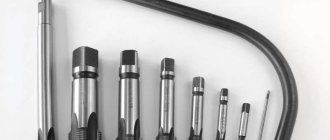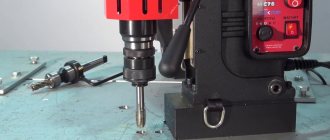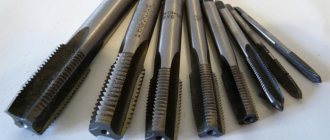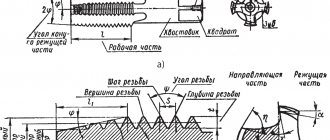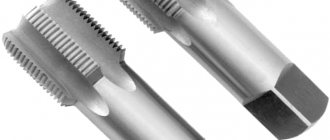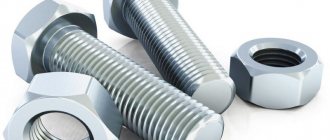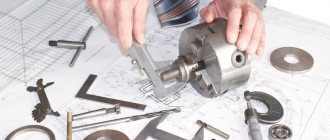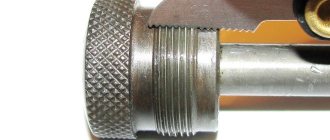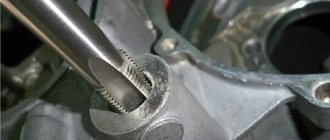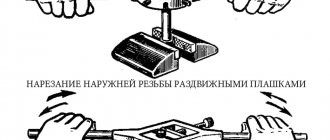Oleic acid belongs to the category of unsaturated acids and is (of all unsaturated acids) the most common in nature, especially in vegetable oils (olive, palm, sunflower) and animal fats. Externally, it is an oily liquid without color or odor, although the acid used for industrial purposes (rubber production, metalworking) may have a yellowish tint. This type of acid received its name “oleic” thanks to olive oil, where it contains more than 80%. However, it is also found in many other products, in particular in peanut butter - about 65%, in sunflower and beef fat - about 40%.
How to lubricate taps and dies for cutting excellent threads
I came to the plant back in 2002, my mentor smeared the taps with melted lard.
He made the rendered lard himself; he is a hunter. He willingly shared the captured product with us; the carving actually turned out quite good. The caliber of the plug and the rings tightened quite well. When the lard ran out, we smeared it with either oil or oleic acid. With oil, the taps were already seated on 50 parts, the calibers did not fit or failed. With the oleinka of those years, the situation was much worse; as soon as the parts were not washed, a white coating grew on them within 3 hours. Which was already quite difficult to wash off. Currently, oleic acid has become slightly different in composition. There is no such raid anymore. But in order to save this product, I recommend adding a portion of oil to oleic acid in a ratio of three to one. This way the mixture remains liquid and is used more economically. If you tried it with your fingers, oleic acid is not slippery and does not have the properties of an oil. But by adding oil, you will improve its lubricating properties without losing the properties of oleic acid, and its oxidation in the open air will also decrease.
Tip: Keep concentrated oleic acid in a closed container, so it will oxidize less and will not turn black and thick.
Even after keeping the parts in the air for a long time, deposits will stop appearing, and the finished parts will be washed well even with ordinary coolant.
To wash small parts, I use a plastic fruit box and coolant pressure from a conventional lathe. The parts come out clean and shiny; any remaining chips and oil are washed off. After washing the coolant, they do not rust for a long time.
Source
Properties and scope of application of oleic acid
This type of acid is harmless when it comes into contact with human skin and does not dissolve in water. For removal you can use alcohol, acetone, chloroform, ether. During operation, it is necessary to take into account that when interacting with oxygen and ultraviolet radiation, the substance oxidizes and darkens. Therefore, oleic acid should be stored in an opaque, tightly closed container.
The scope of application of oleic acid is extensive and covers many areas of human activity - from medicine and cosmetology to metalworking and the production of rubber products. In particular, oleic acid is used in the food industry in the production of flavorings, and in the pulp and paper industry as a cellulose plasticizer. It is also used in the production of varnish, drying oils, and emulsifiers. This type of unsaturated acids is widely used in metalworking, especially as a cutting fluid in metal-cutting operations.
Thread cutting lubricants
Help with the composition of a lubricant for cutting stainless steel threads with a hand tap.
Pork lard - any kind, salted or not. This is quite serious!
Or what’s left in the jar after eating sprats.
Why not lithol, for example?
This is how this lithol is structured, which is inferior in this regard to lard and oil
.
And I spray with silicone grease and don’t bother. But large wood should not be cut this way.
Why bother so much with the composition of thread-cutting oil - if the branded oil is not that expensive. RIDGID oil - 722 rubles for 5 liters, or 240 rubles for 0.6 liters of spray - and cut threads with pleasure! Description here » > Sincerely, Alexey
Wild wrote: Help with the composition of the lubricant for cutting stainless steel threads with a hand tap.
Castor oil (castor oil)
They advised: 1) Oleic acid 2) Lard I haven’t tried it myself.
marat_k wrote: They advised: 1) Oleic acid 2) Lard I haven’t tried it myself.
We haven't tried the lard. I do not believe!!
Oleinka is harmful to health. It’s a shame to transfer lard to carving! Castor oil is just right.
Alex___dr wrote: Oleinka is harmful to health.
2Alex___dr
just a regular spindle, drip slowly and that’s it
Everyone, thank you very much for your advice. I will gradually try everything.
To summarize: 1. Drying oil or spindle. The most common. For steel. I do not like. Cleaning the instrument is bad. 2. Pork lard. It will go everywhere. Easy to clean. Licked it and that's it
(look where I'm from)
- Kerosene. Only light alloys based on aluminum and magnesium.
- Castor oil. Can be used everywhere. The most reliable tool for cutting titanium. Perhaps even the only one that guarantees quality.
Source
CLAIM
A lubricant for mechanical processing of metals containing castor oil, stearic acid, finely ground sulfur, characterized in that the lubricant additionally contains oleic acid in the following ratio of components, wt.%.
It belongs to the category of unsaturated acids and is (of all unsaturated acids) the most common in nature, especially in vegetable oils (olive, palm, sunflower) and fats of animal origin. Externally, it is an oily liquid without color or odor, although the acid used for industrial purposes (rubber production, metalworking) may have a yellowish tint. This type of acid received its name “oleic” thanks to olive oil, where it contains more than 80%. However, it is also found in many other products, in particular in peanut butter - about 65%, in sunflower and beef fat - about 40%.
Trefolex - compound for drilling and threading in metals
The compound, as the manufacturer assures, facilitates drilling and increases tool life. Used for any operations with hand tools, drilling, threading, reaming and others.
Jar 500 gr. Packed by the seller simply in a cardboard box.
The paste is a light green, funny color, at room temperature like very thick sour cream, with a slight limonella smell. When heated, it turns into a liquid similar to “tarragon”.
Not flammable. Non-toxic, allergic reactions are possible (not yet detected).
Upon request, a photo of the back of the can:
Does not oxidize iron and stainless steel, aluminum, copper, bronze turns black from it.
It really works, it drills much better, cutting threads with it is a pleasure, the chips flow out from under the dies, the thread is obtained without scuffing, the effort is much less.
If you work with it, your hands won’t get black like oil, it’s easy to wipe off your hands and that’s it.
If used in machine processing, I did not find any differences from oil, except for purity and the fact that it is thicker and does not flow until it heats up, but with intensive processing it evaporates with the powerful smell of this very limonella.
The price tag is not humane, but the product is used very economically - it is enough to immerse a drill or tap in it before work, so the can will last for a very long time.
Source
Steel threading lubricant
Over the last decade, the need for materials that can not only provide effective lubrication, but also prevent seizing in friction units, eliminate the seizure of threaded connections and minimize the wear rate of mating surfaces operating in various corrosive environments and under conditions of a wide temperature range has increased significantly. Due to this, thread lubricant today has become incredibly popular in all sectors of the national economy, but more stringent requirements have begun to be imposed on it, including:
- absence of environmentally hazardous and aggressive components towards rubber goods;
- resistance to vibrations and critical temperatures;
- low volatility of the dispersed medium;
- affordability;
- homogeneity.
Tallow
The cold preparation of wheel ointment is based mainly on the property of resin (rosin) oil to combine with lime.
For this purpose, use fatty slaked lime containing at least 96% pure lime. The presence of even 5-8% magnesium in it already deteriorates the final product. Good lime dissolves easily in rosin oil at 15-20 o C. Heavy grades of mineral oils are added to their mixture.
Mineral oil is mixed with well-dried slaked lime in a tank for half an hour and the mixture is passed through a sieve, the mesh of which has 25-30 holes per 1 cm 2. Large pieces retained in the sieve are ground so that they pass through it freely.
Then oil residues, dyes and, if found advantageous, other neutral mineral substances are added to the mixture, mixed thoroughly again and, finally, without stopping stirring, resin oil is added, and the mixture thickens.
A good wheel wax should have the consistency of cow butter.
Below we give the following recipes for preparing good varieties of wheel ointments using a cold method.
- 75 parts heavy mineral oil, 10 parts slaked lime, 15 parts resin oil.
- 36 parts heavy mineral oil, 36 parts petroleum residue, 12.5 parts slaked lime, 15.5 parts resin oil.
- 60 parts heavy mineral oil, 18 parts gypsum, 9 parts slaked lime, 13 parts resin oil.
- 20 parts heavy mineral oil, 23 parts petroleum residue, 8.5 parts slaked lime, 40 parts gypsum, 8.5 parts resin oil.
English wheel ointment
Melt 1 part lard and add 1 part white lead and 1 part mercury ointment.
Belgian wheel ointment
Take 10 parts of freshly slaked lime powder, 30 parts of crude petroleum jelly, 1 part of caustic potassium, water as desired, wash with heat and add 30 parts of birch tar, 80 parts of petroleum jelly, 80 parts of talc and burnt bone or soot as needed.
Hoof ointments
You can make your own hoof ointment; here are a few recipes:
- Melt 2-3 parts of ozokerite, 8 parts of vaseline oil, 1 part of soot.
- Take 12 parts of rosin, 17 parts of bovine fat, 2 parts of Japanese wax, 5 parts of varnish, 3 parts of soot.
- Take 10 parts of bovine fat, 2 parts of yellow wax, 2 parts of birch wax, 2 parts of pitch, 1 part of soot.
- Melt 2 parts gutta-percha, 1 part ammonia gum. Before use, the mass is softened in hot water and smeared into previously cleaned hoof cracks.
Taps
The internal threads on the parts are cut using taps.
Taps for cutting inch and metric threads are usually manufactured in sets of two.
Taps for inch threads (less than 2 inches) and for metric threads from 32 to 54 mm with a pitch of more than 3 mm are manufactured in sets of three pieces. Such sets include the first (rough), second (medium) and third (finishing).
There is one circular mark on the tail of the first tap, two on the tail of the second, and three on the tail of the third.
The thread size is also indicated on the tail of the tap.
When cutting threads by hand, a special driver is used for the tap.
More details about video tags at the end of the article.
How to cut a thread with a tap
At first glance, cutting a thread with a tap looks simple, but this does not mean that it will be easy the first time. Pay special attention to choosing a quality tool. A dull tap has every chance of breaking. Getting the fragment out of the hole is still a hassle.
When cutting threads, follow the rule: 1 - 2 turns forward (cutting threads) - 0.5 - 1 turn back.
When cutting threads in blind holes, chips will inevitably accumulate; it is necessary to unscrew the tap and remove metal waste from the hole and from the tap.
If the tap has been removed completely, be careful when screwing it in again or when passing the next number. It is necessary to hit the already cut thread and not cut it.
The diameter of the drilled hole must correspond to the diameter of the thread (Table 1):
| Thread diameter | Hole diameter | Thread diameter | Hole diameter |
| 1 | 0,75 | 2,6 | 2,15 |
| 1,2 | 0,95 | 3 | 2,5 |
| 1,4 | 1,15 | 3,5 | 3 |
| 1,7 | 1,35 | 4 | 3,3 |
| 2 | 1,6 | 5 | 4,1 |
| 2,3 | 1,9 | 6 | 4,9 |
| 2,5 | 2 | 8 | 6,7 |
Deviations from the specified values will lead to poor-quality threads.
And of course, don’t forget about lubricants (oil, kerosene, grease, etc.).
How to lubricate a tap when cutting threads in aluminum
The most accessible ingredient for thread cutting is a piece of lard.
Seriously, no jokes. But in general there is a special composition - Petrov's grease, oleic acid - 78, stearic acid - 17, fine sulfur - 5. Stearic acid can be obtained from stearic candles (simply melting them in mixture).
For soft metals, you can also spray wd40 (well, in principle, it’s the same kerosene)
Stop. The lard must not be salted. Where can I get a stearin candle?
You can get this at home too. A mixture of oleic and stearic acid can be obtained: take soap, preferably laundry soap, make shavings with a knife, and dissolve it in water. as much as possible. Add hydrochloric acid to the resulting soap solution (namely hydrochloric acid, it is volatile and will not remain in the stearin after drying). Stearic acid will fall out, as well as oleic and palmitic acid, dry it. It needs to be dried in a desiccator, but not everyone has one, you can dry it in a plastic bucket with a lid; in the bucket next to the resulting stearin there should be a canvas bag with calcined soda ash. It absorbs water vapor and hydrochloric acid vapor. The result was the desired mixture of oleic and stearic acids. It looks like wax; stearin candles were previously made from this mixture. Previously they were made as waste from soap factories, but now they have been replaced by wax.
Source
Lubricant-cooling technological means (COTS) for manual application.
The ROCOL ® company is a world leader in the development and production of lubricating and cooling technological products for metal cutting and forming!
® metalworking lubricants produced by ROCOL ® contain technologically advanced extreme pressure additives that reduce friction and minimize contact of the metal-cutting tool with the workpiece material, therefore significantly increasing the life of an expensive tool in comparison with standard manually applied COTS.
RTD ® metalworking lubricants are designed to:
- Achieving peak performance
- Reduces friction and achieves double tool life
- Reducing wear and tear on equipment
- Improving the quality of metal processing and the formation of an ideal surface
- Increasing metal removal rate
- Reducing the amount of waste and scrap metal
- Compatible with most types of metals and alloys
Special dies and taps
Special dies and taps are tools that are manufactured with various deviations from DIN, ISO, ANSI and other standards. Changes may affect the degree of accuracy, the length and shape of the shank, the number of threads per inch, thread pitch, diameter of the thread being cut and other parameters.
Standard tools and taps are made from HSS grade high-speed steel, as well as from improved high-speed steel with the addition of vanadium and cobalt grade HSS-E. Various wear-resistant coatings are also applied to special taps.
External thread cutting with a die
To cut external threads, you will need the following tools and materials: a die or pipe clamp, a die holder, a file, a vice, a caliper, and machine oil.
The most widespread are round dies (lerks). They are either solid or split. The diameters of solid round dies are standardized. This allows you to choose the appropriate option from a large range of sizes, for example, M10, M12, M14, M16.
A special feature of split dies is the ability to adjust the diameter of the thread being cut within 0.1…0.25 mm. However, they have reduced rigidity, which affects the accuracy of the resulting profile.
The die is installed in a die holder of a suitable size. After this, it is secured with screws. In the case of external pipe threads, die holders with a ratchet are often used. They provide convenience for working in hard-to-reach places, such as near a wall.
The thickness of the rod is chosen to be 0.1...0.25 mm less than the diameter of the external thread. For example, for M6 with a large pitch it is 5.80...5.90 mm; M8 – 7.80…7.90 mm; M10 – 9.75…9.85 mm. Measurements are taken using a caliper. The diameters of rods for cutting metric threads of average accuracy class 6g are presented in the table.
To ensure better insertion of the die, a chamfer is filed at the end of the rod. Its width should be 1 - 1.5 mm for M6 ... M18. The workpiece is lubricated with machine oil, which makes subsequent work easier and allows you to obtain a better surface.
The die is placed on the end of the rod so that its plane is perpendicular to the axis of the bolt being cut. Next, with slight pressure, rotate the die holder clockwise (if the thread is left-handed, then counterclockwise). When the die cuts into the rod by one or two threads, it should be turned back half a turn for better removal of chips. After this, they again make 1-2 turns along the thread and 0.5 in the opposite direction. Using this scheme, the bolt is cut to the required length.
The diameter of the external thread is checked with a regular nut or ring gauge. If necessary, the pitch is controlled with a thread gauge.
Tap selection and cutting
A tap is selected depending on the thread that is needed, as well as its purpose (the thread may differ in profile shape, thread pitch, tolerances).
To select a tap, there is a table that shows the accuracy classes - in accordance with them, you need to choose what type of tap to purchase - a set or a single tool.
An important factor to consider when choosing a tap is the required accuracy of profile cutting.
Different tools have different finishes on the cutting element, and this also needs to be taken into account.
The metal you will be working with will directly affect the tap you will need for it.
On aluminum, a sharpening angle of at least 25 degrees will be required, on cast iron and copper up to 5 degrees will be enough, and on steel – up to 10 degrees.
For the manufacture of the tap itself, ordinary or high-strength steel is most often used. When choosing, you need to focus on the diameter of the hole in which the thread will be made.
Before creating threads in aluminum, cast iron or other metal parts, you need to make a hole. It can be through or blind, depending on the need.
The hole can have any diameter, it is only important that it be smaller than the future cutting. It is best to choose a drill bit for the hole based on the thread size.
There is a special table that shows the recommended drill diameter in accordance with the thread size; it is recommended that you familiarize yourself with it before starting work.
If you need to make a large wall thread on cast iron or aluminum, then you should choose the diameter for the hole by multiplying the thread diameter by 0.8, so you will get a value that will be closest to the required size.
Creating a hole for an internal thread is not done manually, but using a special drilling machine or electric drill.
If using a drill, the workpiece must first be clamped in a vice so that the drilling location is exactly where it is needed.
When drilling, the drill must be positioned strictly vertically and not deviate from the specified plane.
To make it easier to work with a tap, you can chamfer the top edge - then the device will fit easier.
This can be done using a drill with a larger diameter or a file. After finishing the work, the hole must be cleared of chips.
This must be done especially carefully in a blind hole, otherwise cutting will not work well.
Before drilling, the part you will be working with must be firmly secured with a vice, with the chamfer on top, and the axis of the hole you made must be perpendicular to the table.
The tap must be fixed into the socket of the driver, and then inserted into the chamfer of the workpiece hole. The device is always inserted vertically.
After this, you need to press the tap firmly against the workpiece (preferably with both hands) and begin to rotate it clockwise.
Sudden movements or stops should not be allowed: the device must be rotated slowly and evenly, but at the same time work with pressure.
You need to work with the tap in the following sequence: first two turns forward, then half a turn back and then forward again. This method involves processing the entire hole in the pipe.
The tap needs to be cooled from time to time while cutting.
Different cooling methods are used for different metals: kerosene will be effective for aluminum, turpentine will be effective for copper, a special emulsion will be effective for other metals, and when cutting in cast iron, cooling the device is not required.
For internal threading, it is best to use tap sets.
The work is as follows: first you need to make a rough thread, then use a medium tap, which is passed through the hole, and then the final cut is formed using a finishing tap.
This sequence is optimal for the best processing quality, so it is recommended not to skip any of the three devices, otherwise the quality of the thread in the pipe will be noticeably worse.
You can see all the stages of the cutting process in the video - there is nothing complicated in this process, the most important thing is to choose the right diameter and follow the sequence of work, and also remember how to work with this or that type of metal.
In this case, you will receive high-quality threads in the pipe, which can be used to connect any parts.
No similar articles found.
Currently, it is difficult to imagine carrying out metalwork work without a special thread-cutting tool.
This tool can cut threads on products made of non-ferrous metals and steel.
DOMOSTROYPlumbing and construction
Rules for cutting threads with a tap:
1) when cutting threads in deep holes, in soft and tough metals (copper, aluminum, babbitts, etc.), the tap must be periodically unscrewed from the hole and the tap grooves must be cleared of chips;
2) thread cutting should be carried out with a full set of taps. Cutting a thread immediately with a medium tap without going through a rough tap and then a finishing one does not speed up, but, on the contrary, complicates the work, leads to poor-quality threads, and sometimes to breakage of the tap. The second and third taps are inserted into the hole without a driver and only after the tap passes correctly along the thread, the driver is applied and threading continues;
3) blind holes for threads must be made to a depth slightly greater than the length of the part being cut, so that the working part of the tap extends slightly beyond the part being cut. If there is no such reserve, the thread will be incomplete;
4) during the cutting process, it is necessary to carefully ensure that there is no misalignment of the tap; To do this, every 2-3 threads you need to check the position of the tap in relation to the upper cut plane of the product using a square. Particular care must be taken when cutting threads in small and blind holes;
5) Cooling and lubrication are used to reduce heat on the tap and produce smoother, cleaner threads. A tap without lubrication heats up quickly and can jam and strip the thread. Emulsions, drying oil or oil (boiled, linseed) are used as lubricating and cooling liquids when cutting threads in steel products; kerosene is used in aluminum products; turpentine is used in copper products;
6) thread cutting in bronze and cast iron parts can be done dry.
It has been noticed that on many Golfs the rear engine mount (or gearbox) mount is a problem area, namely the internal thread in the aluminum gearbox housing.
So I haven’t had a thread for a long time, I noticed even from the purchase that it wasn’t screwed
, but the pin at 12 is clogged)) Recently it made itself felt, unpleasant sounds appeared when starting and braking, and when I reached out to replace the pillow, the bolts simply wouldn’t screw back in.
While the repair kit was coming from China (analogous to Helicoil), I somehow drove on my word of honor for a month until the bolt completely fell out))
Well, now let’s get to the point: this is what a set of Chinese threaded inserts with a tool for restoring M12x1.5 threads looks like - solid quality 4
The insert has a depth of 14 mm or 9 turns, which in the end turned out to be quite enough.
I measured the depth of the hole so as not to waste
A tap is a tool that can be used to quickly and accurately cut a thread in a prepared hole. This is a rod divided into a working part and a shank. The shank is used for fixation in the driver or chuck of the machine. Chip removal is provided by longitudinal or helical grooves located on the cutting part. For the manufacture of this tool, carbon or high-speed steels are used. To cut internal threads efficiently, you need to know how to choose the right tap and prepare the hole.
Thread gauge
To control the profile shape, diameter and thread pitch, special and universal tools are used.
A thread gauge is used to check the thread profile.
For precise control, special microscopes are sometimes used. The diameter of the thread can also be measured with a caliper.
Every person involved in the installation of metal structures or performing various repair work should know how to cut a thread manually. This is one of the basic skills of plumbing, which experienced workers have brought to automaticity.
Taps are designed to be grasped by a rotating tool (wrench) or secured in a machine chuck.
Preparing to cut internal threads
In order for the process of cutting internal threads using a tap to not cause any particular difficulties and result in a high-quality result, it is necessary to properly prepare for this technological operation. All methods of cutting threads using a tap assume that a hole with the appropriate diameter has already been made in the workpiece. If the internal thread that needs to be cut has a standard size, then a special table with data in accordance with GOST can be used to determine the diameter of the preparation hole.
Table 1. Diameters of holes drilled for standard metric threads
If the thread that needs to be cut does not belong to the standard category, you can calculate the diameter of the hole to make it using a universal formula. First of all, it is necessary to study the marking of the tap, which must indicate the type of thread being cut, its diameter and pitch, measured in millimeters (for metric). Then, to determine the cross-sectional size of the hole that needs to be drilled for the thread, it is enough to subtract the pitch from its diameter. For example, if a tool marked M6x0.75 is used to cut a non-standard internal thread, then the diameter of the preparation hole is calculated as follows: 6 – 0.75 = 5.25 mm.
For standard threads belonging to the inch category, there is also a table that allows you to choose the right drill with which to carry out the preparatory work.
Table 2. Diameters of holes drilled for inch threads
An important question to obtain a high-quality result is not only the question of what is used to cut the thread, but also what drill to use to make the preparation hole. When choosing a drill, you need to pay attention to the parameters and quality of its sharpening, as well as to ensure that it rotates in the chuck of the equipment used without runout.
The sharpening angle of the cutting part is selected depending on the hardness of the material that needs to be drilled. The higher the hardness of the material, the greater the sharpening angle of the drill should be, but this value should not exceed 140°.
When drilling blind holes, control the drilling depth
How to cut threads correctly? First you need to select tools and consumables:
- an electric drill or drilling machine capable of operating at low speeds;
- a drill whose diameter is calculated or selected using reference tables;
- a drill or countersink, with the help of which a chamfer will be removed from the edge of the prepared hole;
- a set of taps of the appropriate size;
- manual holder for taps (drives);
- bench vice (if the product in which the thread needs to be cut needs to be fixed);
- core;
- hammer;
- machine oil or other composition, which during the processing process must be used to lubricate both the tap and the thread section being cut by it;
- rags.
Diagram of thread cutting with a tap
Work procedure
In order to correctly perform the entire range of thread cutting work, it is recommended to adhere to a certain sequence. This is important when you need to provide a good hundred connections, as when assembling metal structures. You need to start with marking, which is done using a tape measure or ruler in accordance with the drawing. Having measured the indicated distances from the base sides, place a mark with a pencil at the found point. Marking is done for all holes at once or for those that the worker can reach while at a height.
Next, having pointed the core at the intended location, apply one calculated and precise blow to create a clear depression. Naturally, before starting the procedure, the core must be sharpened properly. In the same way, you need to mark all the locations of future holes. The drill bit is then secured in the drill chuck and lubricated, after which you can begin making the hole. The speed of the drill must be adjusted in advance so that it is low.
Drilling is done carefully, with medium pressure, holding the drill without distortion at an angle of 90° to the surface. The power tool should not be allowed to wobble in different directions; this will increase the breakdown of the hole. It should be taken into account that at the moment the drill comes out from the other side, some force and a slight increase in the number of revolutions will be required. If the metal is thick, then the working part must be lubricated several times during the process. When all the holes are ready, a countersink is inserted into the chuck and chamfered.
The last stage is thread cutting. The sequence of this operation is the same for all types of taps. Having clamped it in the driver and pre-lubricated it, the end of the tool is inserted into the hole, also maintaining an angle of 90°. Lightly pressing the knob from above so that the first turns of the working part can catch on the edge of the chamfer, make the first turn. Further rotation occurs without pressure according to the algorithm: one revolution forward, half a revolution back to discharge chips. With machine taps that perform threads in one pass, you must act carefully: the tool is fragile and breaks easily. Complete products are easier, but here you need to run the threads with the first number, then the second, and so on.
Features of the technology
When cutting internal threads with a tap, the following algorithm is used.
- In the place on the surface of the workpiece where the hole for threading will be drilled, it is necessary to form a recess for a more accurate entry of the drill, using a core and a regular hammer. The drill is fixed in the chuck of an electric drill or drilling machine, on which low rotation speeds of the tool are set. Before starting drilling, the cutting part of the drill must be treated with a lubricating compound: a lubricated tool enters more easily into the structure of the material being processed and creates less friction in the processing area. You can lubricate the drill with a piece of ordinary lard or grease, and when processing viscous materials, machine oil is used for these purposes.
- If it is necessary to cut threads in small parts, they should first be fixed using a bench vice. When starting drilling, the tool fixed in the equipment chuck must be positioned strictly perpendicular to the surface of the workpiece. You should lubricate the tap regularly and ensure that it does not warp and moves strictly in the given direction.
- At the entrance to the hole, as mentioned above, it is necessary to remove the chamfer, the depth of which should be 0.5–1 mm (depending on the diameter of the hole). For this purpose, you can use a larger diameter drill or countersink, installing them in the chuck of drilling equipment.
- The process of cutting internal threads begins with tap No. 1, which is the first to be installed in the driver. We should not forget about the lubricant, which must be applied to the tap for threading. The position of the tap relative to the hole being machined must be set at the very beginning of the work, since later, when the tool is already inside the hole, this will not be possible. When cutting a thread with a tap, you must adhere to the following rule: 2 turns of the tap are made in the direction of cutting the thread, 1 - against the direction. When the tap makes one revolution back, chips are thrown off its cutting part and the load on it is reduced. Thread cutting with a die is performed using a similar technique.
- After cutting the thread with tap No. 1, tool No. 2 is installed in the driver, and after it – No. 3. They are processed according to the method described above. When cutting threads with taps and dies, you need to feel when the tool begins to rotate with force. As soon as such a moment occurs, you should turn the knob in the opposite direction to throw the chips off the cutting part of the tool.
Drill selection
An electric drill is necessary to perform internal threading work.
Before cutting a thread with a tap, you must first drill a hole for it. It is absolutely clear that the diameter of the hole should be smaller than the size of the tap, but how much? There is a universal way to calculate this difference. Any thread is characterized by two parameters:
- diameter, indicated on instruments with a capital letter M in front, for example, M6;
- The pitch of turns is written as a number after the first parameter, for example, M6x1.
By looking at the markings on the tap, it is easy to select the drill for the job. It is necessary to subtract the thread pitch from the diameter value; in the given example, M6x1, you will need a hole measuring 6 - 1 = 5 mm. The drill should be a regular cylindrical one; for metal processing, these are made from high-speed steel R6M5. In order to facilitate the selection of sizes, Table 1 presents the recommended diameters for the holes of the most common metric profile threads.
Since we are talking about manual metal processing, one feature should be taken into account when selecting drills. When working with an electric drill, no matter how hard you try to keep it level and motionless, the hole will break and its size will be slightly larger than necessary. As a result, after passing with a tap, the thread turns will have a cut profile. When the bolt is screwed in, there will be some play, and if the tightening torque is high, the coils may simply become deformed. The size of the hole depends on two factors:
Countersinks are needed for chamfering when cutting internal threads.
- The larger the diameter, the more the hole unfolds. For example, with D = 5 mm there is an increase of 0.08 mm, and with D = 10 mm there is already an increase of 0.12 mm.
- Working conditions. The mechanic may be in an awkward position or at a height, this will cause increased hole breakdown, which will then affect the quality of the connection.
The problem is solved as follows: to make the internal thread full-profile, you must initially take a drill whose diameter is 0.1 mm less than the required one. It is possible that in some cases it will be difficult to rotate the tap, but usually no difficulties arise.
To perform internal thread cutting you will need:
- marking tools (tape measure, ruler, pencil);
- electric drill with a set of drills;
- countersink for chamfering;
- set of taps with hand crank;
- hammer;
- core
Drills should be threaded (sharpened) in accordance with the hardness of the material being processed. The harder it is, the greater the sharpening angle needs to be maintained. During drilling and cutting, the working parts of drills and taps must be lubricated. The choice of lubricant type depends on the viscosity of the steel. For regular and carbon steel, old lard or grease is suitable, for stainless steel - machine oil.
Useful tips
- In order to correctly cut threads in metals with low hardness and high viscosity, such as aluminum, alloys based on it, copper, babbitt, it is recommended to periodically remove the tap to clean the channels from adhering chips.
- When using complete models, the complete set should be used. Skipping the roughing tool does not speed up, but slows down cutting. Such a violation of technology leads to a decrease in the quality of the result, and sometimes to failure of the tap.
- To prevent the tap from skewing, check the verticality of its position after 2-3 threads using a square. This precaution is especially important for blind and small holes.
The process must be carried out using liquids intended for lubrication and cooling:
- emulsions, linseed oil, and drying oil are used in steel elements;
- in products made of aluminum and its alloys - kerosene;
- when processing copper - turpentine.
It is possible to cut threads in parts made of cast iron or bronze without the use of lubricant.
Source
